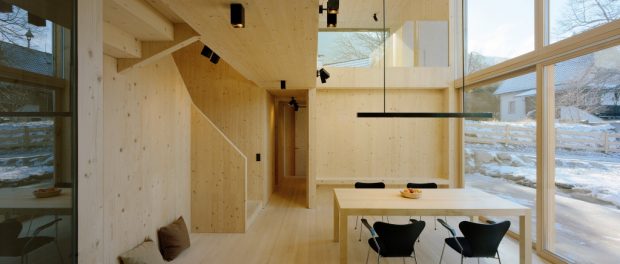Stora Enso teams up with the Technical University of Munich to unveil study into well-being benefits of building with wood

Stora Enso Wood Products, a leading provider of sustainable wood-based solutions, has today launched its whitepaper showcasing the science behind the health and well-being benefits of building with wood. Developed in partnership with the Technical University of Munich, the unique in-depth literature review dissects the increasing volume of evidence in this field that proves wood to be a stand apart building material option.
Considering in the developed world, around 90% of our time is spent inside – something that’s been exacerbated in recent times by the COVID-19 pandemic – it is more important than ever to assess wellbeing whilst indoors, and the whitepaper demystifies the role building materials play in this.
The analysis reviews multiple areas of research, such as wood’s ability to reduce stress and boost productivity levels. For example, a study into the wooden waiting room at the National Oncology Institute in Slovakia saw participants experiencing a decrease in cortisol levels by 7.5%, implying a stress-reducing effect[1]. Similarly, a study conducted in an Austrian school compared student experience in classrooms – one with linoleum floors and plasterboard walls, and one that was wooden. Those in the wooden classroom had significantly lower heart rates and lower perception of stress[2].
Hygiene is also covered, with studies showing Coronaviruses (SARS -CoV-2) applied to wooden surfaces can only be replicated for 12 hours, whereas on surfaces made of plastic, stainless steel, glass and masonry, the viruses remain multipliable for up to 96 hours[3]. Additionally, research has shown that exposure to essential tree oils can result in an increase in natural killer (NK) cells which is an indicator of a strengthened immune system[4].
“Building with wood has many benefits, such as lowering environmental impact – CO2 emissions can be reduced by up to 75% when comparing against traditional processes with concrete and steel. But often underappreciated, is how it can improve health and wellbeing,” says Sebastian Hernandez, Building Concepts Manager, Building Solutions, Stora Enso Wood Products. “There is still a lot to learn in this field. And with the role the construction industry plays in societal impact in acute focus, we hope that our study spurs an increased interest in research in the future.”
Air humidity too is addressed in the whitepaper as research shows wood can keep the ideal range of humidity (40-70%) for a longer period of time. This can help to reduce allergenic irritations as well as the spread of bacteria and viruses. For example, one study shows when comparing two identical rooms, one covered with gypsum plaster and the other with various wooden surfaces, air humidity fluctuation was reduced by up to 70% in the wooden room[5].
“While research into the impact of wood as a building material has been ongoing for more than 20 years now, it is rarely brought together and analysed as a whole,” says Eva Bodemer, Technical University of Munich. “This report represents a significant and in-depth review of research to provide the industry with a holistic understanding of the role wood can play, particularly regarding the all-important aspect of wellbeing.”
To view the 10 key well-being benefits of building with wood
in the full whitepaper, read more here.
[1] Kotradyova et al 2019: Wood and Its Impact on Humans and Environment Quality in Health Care Facilities
[2] Grote et al., 2003: Gesundheitliche Auswirkungen einer Massivholzausstattung in der Hauptschule Haus im Ennstal. Österreich: Human Research Institut.
[3] Domig and Wimmer, 2020: Coronavirus on wood surfaces- Is there a risk?, https://www.timber-online.net/wood_products/2020/03/coronavirus-on-wood-sur- faces-is-there-a-risk.html
[4] Li, Q. et al. 2009: Effect of phytoncide from trees on human natural killer cell function. Nippon Medical School Tokio; rbb-online.de; Baumkunde
[5] Lenz, Krus and Holm, 2005: Feuchtepufferverhalten von Innenraum
